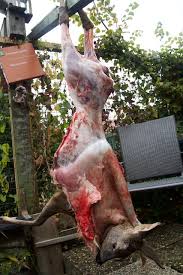Skinning is easier when the body is still warm.
This is usually done with other animals to use the coat as fur or leather. In pigs rarely. The skin remains on the bacon or ham. Pork rind it is even eaten or processed (in sausages or head cheese), or as a snack (nibbling bacon, scratchings, cracklings).
 The work is easiest if you can hang the animal with the hind legs spread with a sturdy rope to a good working height. If it is too heavy, then bind it to a kind of ladder and put it (with some help) against a wall (or tree). If not possible, lay it on the back, and use the skin as working surface.
The work is easiest if you can hang the animal with the hind legs spread with a sturdy rope to a good working height. If it is too heavy, then bind it to a kind of ladder and put it (with some help) against a wall (or tree). If not possible, lay it on the back, and use the skin as working surface.
Between the hind legs, take the skin and make a cut where you push in one or two fingers. Toddle with your fingers the skin loose in the direction of and to the foot. You will always have to cut through the skin. Around the base you cut the skin too. Then do the other leg.
Now work the skin loose right to the ass. Leave a centimeter around the vent stuck. Also skin the back and tail.
Smaller animals can now completely be skinned by pulling down the skin.
For larger you cut the skin from the vent over abdomen and chest to the throat.
You need excessive force. And a knife to cut webs and fiber loose.
Pigs are not poached, but scrubbed and sanded. The skin sticks to the bacon and ham. They are first shaved (if you can use the hair) or burned. To clean them, rub with a grater, e.g. a sardine tin wherein you hit a lot of cavities.
Another scary part: you cut off ears, around eyes and mouth just keep on skinning, and cut the skin loose.
